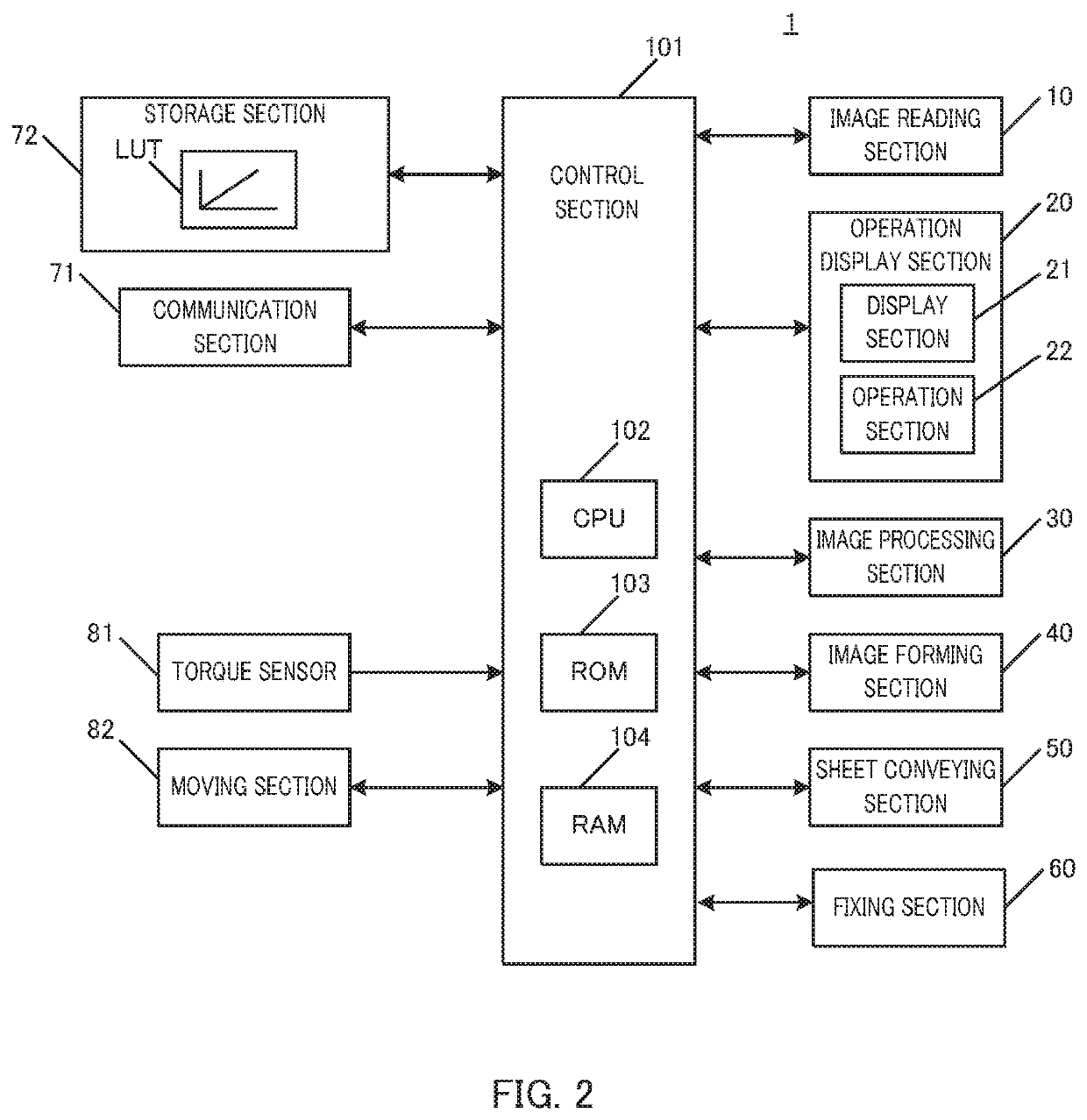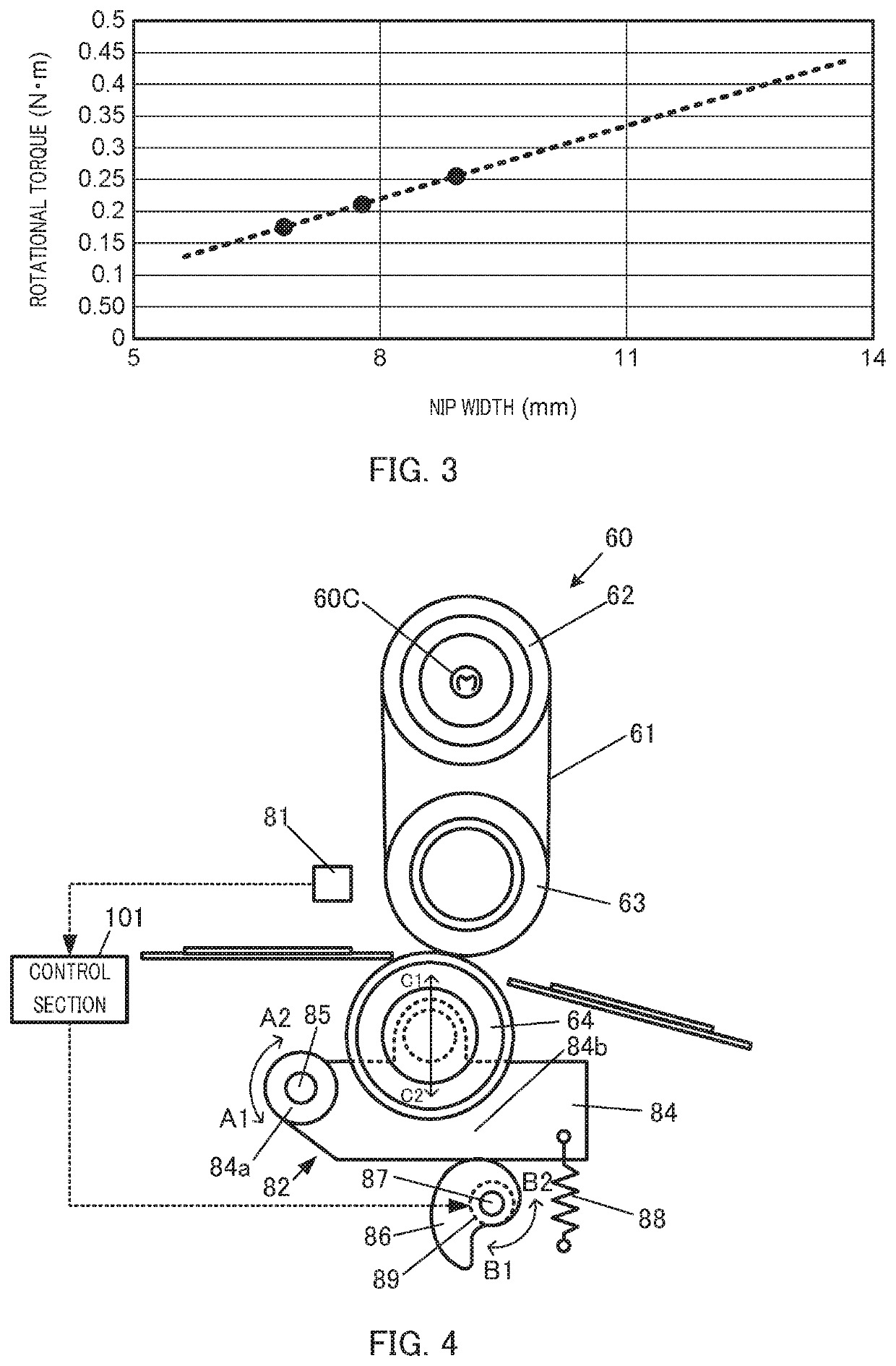Fixing apparatus, image forming apparatus, and nip width controlling method
- Summary
- Abstract
- Description
- Claims
- Application Information
AI Technical Summary
Benefits of technology
Problems solved by technology
Method used
Image
Examples
modification 1
[0105](Modification 1)
[0106]Next, modifications of the present embodiment will be described. Note that in the description of the modifications, a configuration different from that of the embodiment described above will be mainly described. The same configuration will be denoted by the same reference sign and the description thereof will be omitted.
[0107]In Modification 1, fixing section 60 in the envelope mode will be described. In the envelope mode, when the nip width exceeds a predetermined range, a difference in the peripheral speed is caused between upper pressure roller 63 and lower pressure roller 64, which causes a difference in the conveying speed between the two. As a result, wrinkle or image deviation may occur on the envelope after the fixing process. That is, in the envelope mode, it is necessary to convey the envelope with a nip width of the level that upper pressure roller 63 and lower pressure roller 64 are not crushed so much. As described above, in a state where fix...
modification 2
[0110](Modification 2)
[0111]Control of the nip width illustrated in FIG. 5 is performed after lower pressure roller 64 is moved to the pressure-contact position with upper pressure roller 63. In Modification 2, how to determine the pressure-contact position will be described with reference to FIG. 8. FIG. 8 illustrates a relationship between the rotation time of lower pressure roller 64 and the rotational torque. In FIG. 8, the horizontal axis shows rotation time (t) of lower pressure roller 64, and the vertical axis shows rotational torque (N·m). Note that in the description provided below, contact or pressure-contact of lower pressure roller 64 with upper pressure roller 63 via fixing belt 61 is referred to as “lower pressure roller 64 is in contact with, or in pressure-contact with, upper pressure roller 63”. Further, in Modifications 2 to 5, “pressurizing pressure-contact” or “pressurizing pressure-contact operation” means “increasing the pressure in a pressure-contact state”.
[0...
modification 3
[0114](Modification 3)
[0115]Next, in Modification 3, control of the nip width in the envelope mode will be described with reference to FIG. 9. FIG. 9 illustrates a relationship between the rotation time of lower pressure roller 64 and the rotational torque. In FIG. 9, the horizontal axis shows rotation time (t) of lower pressure roller 64, and the vertical axis shows rotational torque (N·m).
[0116]As illustrated in FIG. 9, torque sensor 81 detects rotational torque when an envelope passes through. Control section 101 controls moving section 82 such that the rotational torque detected by torque sensor 81 is maintained at a target value (“passage time pressurizing pressure-contact operation” illustrated in FIG. 9).
[0117]It is not limited that detection of the rotational torque by torque sensor 81 is performed when the envelope passes. It can be performed as long as it is during a printing job, for example. For example, during the inter-sheet period showing a period from the time when a...
PUM
 Login to View More
Login to View More Abstract
Description
Claims
Application Information
 Login to View More
Login to View More - R&D
- Intellectual Property
- Life Sciences
- Materials
- Tech Scout
- Unparalleled Data Quality
- Higher Quality Content
- 60% Fewer Hallucinations
Browse by: Latest US Patents, China's latest patents, Technical Efficacy Thesaurus, Application Domain, Technology Topic, Popular Technical Reports.
© 2025 PatSnap. All rights reserved.Legal|Privacy policy|Modern Slavery Act Transparency Statement|Sitemap|About US| Contact US: help@patsnap.com



